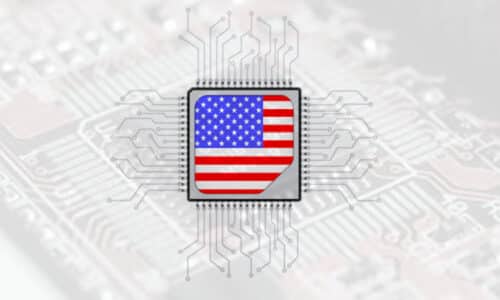India needs to move fast to capture the opportunity that this new world order in semiconductors is creating. In the end, strategy combined with strategic relationships and execution will be the key to success.

The USA President Joe Biden signed The US Chips Act on 9th August, committing his country to a historic realignment of their semiconductor destiny through policy as well as funds for the programme. The genesis of this move has been:
- The polarisation of semiconductor industry into Taiwan and the resulting US-China geo-politics with Taiwan.
- Covid-19 brought home the reality of the global dependence on semiconductors and the fragility of the supply-chain that disrupted downstream industries (“for want of a chip, a ship was lost…”). Of course, Covid-19 escalated the issue, but the disaster was in the making for some years with a series of black swan events hitting the industry starting with:
- Buy-USA policies in the Trump era
- Natural calamities like drought impeding production in Taiwan
- Industrial accidents in different context, different sites across geographies
- And more recently the war in Europe
Over the years, the US semiconductor market has seen silicon shift out of the Silicon Valley, which retained its fabless companies but the semiconductor manufacturing industries migrated to other parts of the world that offered economies of scale, efficient supply-chain ecosystems, and better government incentives.
The US Chips Act aims at redefining the semiconductor industry and getting the semiconductor manufacture back to the USA. This brings several opportunities for India as it builds a mission mode approach to its own semiconductor industry/semiconductor ecosystem. Of special significance are the following:
1. As the USA redefines the global supply-chain ecosystem, India has an opportunity to get a share of the USA fab sourcing by building India’s semiconductor supply-chain ecosystem for global execution. Can the Indian industry—with easy access to Indian deposits of aluminium, copper, zinc, and several other materials of interest for semiconductor industry—move beyond raw material mining and export to creating semiconductor-grade products that meet the growing global needs?
Another opportunity is potentially from taking a share from the supply-chain markets in Asia-Pacific as companies restructure their semiconductor manufacturing supply-chain ecosystems.
A careful focused strategy and selective upgradation of some of our industries can bring these opportunities alive in a manner that meshes with the emerging global and the USA demand.
2. There is another opportunity for India. As the USA and Europe look at scaling up their semiconductor ecosystem, there is a visible deficit of 300,000 skilled people in the global semiconductor industry. At the same time, there is a visible shift away from STEM (science, technology, engineering, and mathematics) focus in the new global generation.
The Indian talent can fill the global workforce gap in high-value manufacturing as well as design with strategic focus, right relationships and planning.
At Electronics Sector Skills Council of India (ESSCI), we are reviewing a stackable skill programme that builds on the foundational degrees in mechanical, electrical, electronics, and materials/chemical engineering. By coupling it with global branded programmes from SEMI (an industry association comprising companies involved in the electronics design and manufacturing supply chain) and leveraging our own academic pool, it is possible to create a strong Indian semiconductor skilled force that can serve the Indian as well as the global demand.
ESSCI is working with industry associations and the government of India’s Ministry for Electronics and Information Technology (MeitY) to build a framework of talent management pipeline and skills—not just for design but for semiconductor manufacturing as well.
3. The semiconductors demand is fundamentally very strong and likely to remain so over this decade. It took the last several decades for the industry to touch $500 billion sales, but it is projected that this figure will double by end 2030 to $1 trillion.
This will be driven by the explosion of data, the Internet of Things, new downstream consuming sectors like the auto sector, life-sciences, and more. Hopefully, India Semiconductor Mission will define its target niches and select a strategic path with viable combinations of sustainable geometries, integration strategies, and go-to-market programmes.
What are these target niches? Essentially, these will likely be select chip-sets that will be relevant to our health security (life science), fintech, and select strategic sector chips.
Going forward, the semiconductor industry is going to see proliferation of products across different node geometries, advanced semiconductor packaging, leveraged heterogeneous integration combining dies with different materials, different functionalities, and even from different fab origins in a SiP (System-in-Package). As terminologies dominate technologies, there will be ample opportunity for India to work with trusted relationships in the USA to build its own semiconductor sectors.
4. The USA is traditionally a high-cost economy. While it will likely capture the higher-value segments in the semiconductor manufacturing, the USA will seek cost-efficient supply-chains, trusted manufacturing partnerships, and skilled manpower for its manufacturing program.
India has evolved from the early 21st century. The new India landscape is increasingly innovation-intensive and we have a proven track record as a software contract engineering services centre. We have a major opportunity to leverage our position in the value-chain and evolve as a trusted, cost-effective contract innovation (R&D and Engineering) partner.
The US Chips Act underscores the need for building trusted relationships to enable India in the new, emerging semiconductor landscape. The US and the global industry will need an agile workforce and efficient as well as cost-effective supply-chains as alternatives to the existing options.
India needs to move fast to capture the opportunity that this new world order in semiconductors is creating. In the end, strategy combined with strategic relationships and execution will be the key to success.
Dr Ashwini K. Aggarwal is an industry leader who has headed various trade associations, including IESA and MAIT, and is currently Director (Government Affairs) at Applied Materials, India





